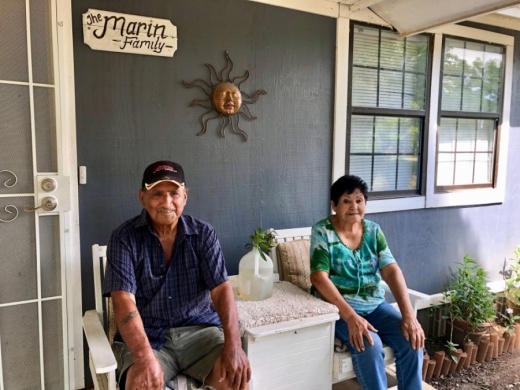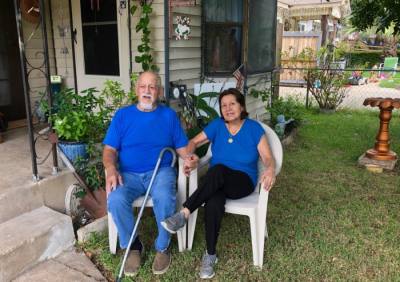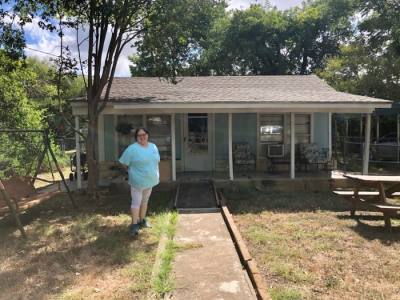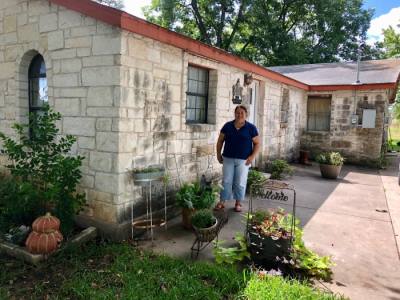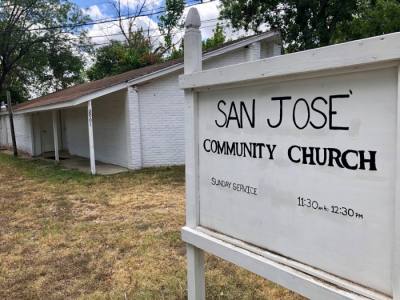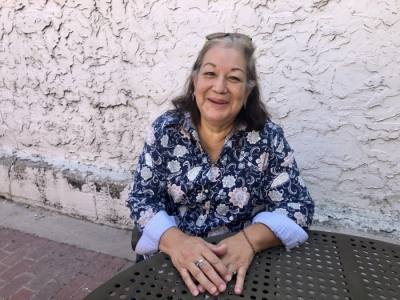“Millers have been here forever,” she said. “My father was born on this land. My grandmother left it to me, and my goal is to give it to my granddaughter.”
Miller said when she is gone, her dream is that the younger generations of her family will hold onto and care for the house, and continue to pass it on.
“It’s part of their history,” she said. “It’s a legacy, and my grandmother always told me, ‘Whenever you have a roof over your head, everything else comes good.’”
For some TRG residents, keeping that roof has become a challenge. Unlike other historic areas of the city, the neighborhood does not have regulations in place to promote preservation. Builders may knock down original homes and are not restricted from replacing them with something significantly larger.
“I have to fight the appraisal district every couple of years because I’m told I have two or three new houses that sold for half a million dollars next to me,” Miller said. “My home is not one of those. Making our tax base go up, it’s a way to push us out.”
City staff and officials began discussing the development of small neighborhood plans in June as a way to slow gentrification in TRG and San Jose, another historic area. The idea is to work alongside current homeowners to identify needs and action items so the neighborhoods will be protected yet developed into the future as the residents see appropriate.
Georgetown Planning Director Sofia Nelson said partnerships with community members will be vital in creating a vision and plan to achieve it with possible city approval this fall.
“These neighborhood plans are a wonderful opportunity, but they must have strong leadership from the residents of these two neighborhoods,” Nelson said to council members in July. “For staff to initiate and lead these without the buy in—without the support of the trusted leaders of these unique communities—that will not get us to an outcome we all desire.”
Staff project designing the two plans will cost about $200,000 out of the fiscal year 2020-21 budget, though some council members were concerned this was too much, as earlier estimates presented to them had been $100,000.
“They’re past due on what they’re doing, but I do appreciate them wanting to try and preserve,” Miller said of the city’s plans. “The Ridge has maybe one or two blocks left that haven’t been invaded.”
Halting excessive building is needed, Miller said. She suggested requiring a number of affordable homes be constructed in the neighborhood per every new and more expensive build.
“Most everyone who has been here is retired, on fixed income or working-class,” she said, adding the price a developer would give for land would not be near enough to buy back in.
“If they’re going to build, make them build according to what other houses look like,” she said. “And make them give back to the neighborhood. Create a park. We don’t have a swimming pool on this side, and now the Boys & Girls Club is moving across the highway.”
Miller said she feels like many of the historic things the community had were taken away.
“We had African American-owned businesses that are gone,” she said. “Don’t just bring back stores to the neighborhood; we want them minority-owned.”
TRG resident Juanita Dominguez-Moore said while the Square’s revival is great for revenue, she often feels like the new businesses are geared toward an Anglo, upper class, a sentiment that Miller also made.
“Why do I still have this feeling of not belonging here?” Dominguez-Moore said. “Didn’t we push that behind us?”
She said her main concern is that TRG’s location close to downtown will cause her to be priced out of her home, which originally belonged to her parents.
“It used to be people didn’t want to come across the tracks over here,” she said. “Now they’re buying it up and driving up everything—taxes, traffic, prices.”
The city needs to listen to residents, as opposed to developers that promise profit, Dominguez-Moore said.
“People like my parents worked hard for those homes,” she said. “The 1950s and ’60s were a hard time for the working class to make a living, especially for people of color.”
She said as the neighborhood’s younger generations graduate, there is nothing here to keep them.
“Most of the businesses are retail, and who can even rent here on minimum wage?” she said.
Growing up in a different part of the city, lifelong Georgetown resident Devon Clarkson said he did not know anything about the history of the TRG neighborhood until he was commissioned to install a mural behind the area’s historic shotgun house at 801 West St.
He said he hopes the mural intrigues residents into asking questions about the historic building and segregation in Georgetown. Mary Smith Bailey, a teacher who founded one of the first preschools for minority children in the city in 1953, is featured.
“I want people to look at her and say, ‘Who was she?’” Clarkson said. “‘What did she do for the community, and why did they pick her to be the person on that wall?’ I want it to spark curiosity about where we were and where we are now. What’s the progress?”
Co-artist Norma Clark was raised in the TRG neighborhood and thus familiar with its history, people and the many changes that have and are still taking place, she said.
“History was incorporated into the mural by including different age groups and generations of people that lived and still live in the neighborhood,” Clark said. “Some went to the old Carver School and Georgetown High School, they were members of the local churches and worked either in the neighborhood or the community.”
She said her objective was for the mural to be colorful, expressive and reflect the community’s stories and journey from segregation, integration, and urban renewal to present day, as well as the things that people in the neighborhood continue to experience today.
“I hope that people think the mural is visually engaging and wonder who the individuals are in the piece, and think about their story and what kind of experiences they faced growing up in this particular neighborhood as well as in Georgetown,” Clark said. “My work is abstract, so it is subjective and people tend to see different things in my paintings that may or may not be there.”
San Jose past meets present
District 1’s Mary Calixtro was one of the council members who initially proposed the neighborhood plans, along with District 6’s Rachael Jonrowe. Calixtro grew up in TRG and now resides in the San Jose neighborhood, in what was her grandmother’s house. Her own grandkids are sixth-generation Georgetown residents.
“You have a lot of grown-grandkids like me living in the houses now,” she said of the area. “They’ve kept the houses or they all live together, two or three generations in a house.”
Calixtro said she does not want to see people pushed out, and she hopes these plans will help residents have a voice in what happens to their neighborhood.
“I want them to have a spot in the conversation,” she said.
Melissa Cortez has lived in what was her grandparents’ house for about 12 years.
“The history here is just as thick and enriched as a couple of blocks down the road, where it’s deemed a historical neighborhood,” Cortez said. “My father and aunt have a lot of stories. Based on what they said, they were segregated over here. It kind of feels like that’s still the same as far as improvements go. I wish they would allocate some funding to improve these streets.”
Cortez mentioned while regulating development and preserving the neighborhood would help with improvements, it could also hinder them if there are laws in place about what can and cannot be done to a person’s property. Miller, as well as several council members, also expressed similar concerns about the restrictions that come with designating an area as protected. City officials said a priority is helping residents understand all aspects of what it would mean to put preservation measures in place.
Glenda Harbert moved into the neighborhood five years ago. She said she knows people have lived there for generations, a fact she loves and would not want to change.
“I hope to see improvements—very few light poles work, and the roads could be fixed up—but I don’t want to change the neighborhood,” she said.
Enrique Marin met Julia, a Georgetown native, when they were both picking cotton in West Texas. He married her in 1958, and they settled in San Jose.
“All these new houses, they didn’t used to be here,” Marin said. “But that’s OK. I just wish the taxes would go down.”
At 82 and 83, the couple now lives in what was Julia’s parents’ home.
“It was a pretty good neighborhood,” Enrique said. “It still is, you know.”
Emilio and Jovita Richarte built their San Jose home about 60 years ago, after they married.
“My daddy gave a piece of land to each of his eight sons,” Richarte said. “I picked this plot. Then the kids started growing, then having kids, and we kept building onto the house. It’s been real good here, real quiet. Once in a while there’s a ruffle, but it’s real quiet.”
Richarte said while the neighborhood remains peaceful most of the time, he dislikes that vehicles often speed through and ignore stop signs.
“It’s the new people coming in,” he said. “I talked to a policeman about this the other day. I was telling him we don’t get officers coming and checking on our neighborhood. We used to have two or three Mexicano officers who would come around, check on us at night. Nobody checks on us now.”
There was also a small grocery store across the street from his house, Richarte said, one where they would give customers credit.
“‘Put it on my bill,’ you’d say,” he recalled with a laugh. The store was one of several that no longer exist in the neighborhood.
“Growing up, we used to bring our report cards to the store owner,” said Calixtro, who played with the Richarte children. “If we had good grades he would give us candy or ice cream. You’d see all these little kids sitting there on the stoop.”
Richarte cited the increase in taxes as an issue. He said he is not sure if his children and grandchildren will keep the house.
“They’ll probably sell it, get the money, forget about the house,” he said, looking across his yard. Regarding how this makes him feel, he shrugged: “Once we’re gone, we’re gone.”
Regardless of what comes of the city’s small neighborhood plans and the houses and families it aims to protect, the past cannot be changed, Miller said.
“At the end of the day, this has been the predominantly African American community, and we’ve already been getting pushed out,” she said of TRG. “And San Jose has been the predominantly Hispanic community. Whether they officially label it or not, this will always be history.”




